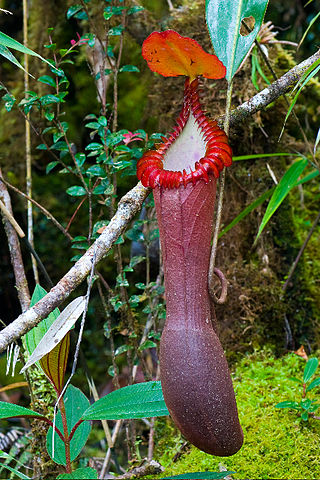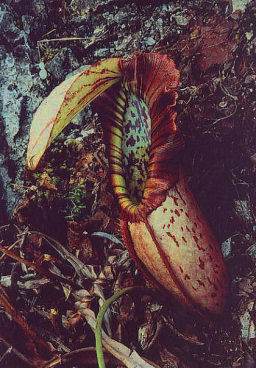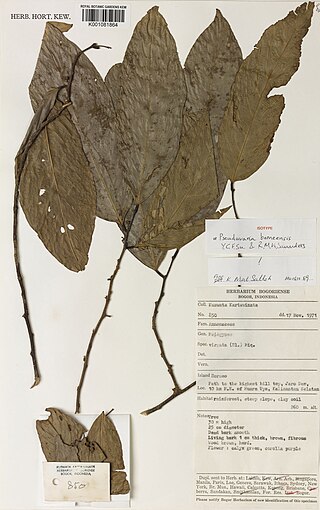
Nepenthes edwardsiana, or the splendid pitcher-plant, is a carnivorous tropical pitcher plant endemic to Mount Kinabalu and neighbouring Mount Tambuyukon in Sabah, Malaysian Borneo. It is considered one of the most spectacular of all Nepenthes, producing some of the largest pitchers and the most highly developed peristome ribs of any species in the genus.

Nepenthes northiana, or Miss North's pitcher-plant, is a tropical pitcher plant endemic to Borneo, where it grows at elevations ranging from 0 to 500 m above sea level. The specific epithet northiana honours the English botanic illustrator Marianne North, who first depicted the species. Nepenthes northiana is one of the most famous Nepenthes, and its discovery in the latter half of the 19th century contributed to Sarawak's reputation as a land of spectacular exotic plants.

Pleiogynium timoriense, commonly known as the Burdekin plum, sweet plum, tulip plum, or in the Djabugay language guybalum, is a medium-sized fruit-bearing tree in the cashew and mango family Anacardiaceae native to Malesia, Australia and the Pacific Islands.

Hymenosporum is a monotypic genus of trees in the family Pittosporaceae. The sole included species is Hymenosporum flavum, commonly known as native frangipani, found in the rainforests and wet sclerophyll forests of New Guinea, Queensland and New South Wales. Despite its common name, it is not closely related to the frangipani, but is related to the widespread genus Pittosporum.

Normanbya is a monotypic genus of palms containing the single species Normanbya normanbyi, which is known by the common name black palm It is endemic to Queensland, Australia and is threatened by habitat destruction.
Dypsis humilis is a rare species of stemless palm that was discovered in Madagascar in 2007 by a collaboration between botanists from Madagascar and Royal Botanical Gardens, Kew. Fewer than ten plants were observed in an area that is threatened by logging and other human activity.

Nepenthes robcantleyi, or Robert Cantley's pitcher plant, is a tropical pitcher plant endemic to the Philippine island of Mindanao. It is closely allied to N. truncata and was once considered a dark, highland form of this species. Nepenthes veitchii from Borneo is also thought to be a close relative.

Buckinghamia celsissima, commonly known as the ivory curl tree, ivory curl flower or spotted silky oak, is a species of tree in the family Proteaceae. It is endemic to the tropical rainforests of northeastern Queensland, Australia.
Madhuca borneensis is a plant in the family Sapotaceae.

Cowiea is a genus of flowering plants in the family Rubiaceae. It is found on Borneo and the Philippines

Pachycentria glauca is a small epiphytic shrub in the Melastomataceae family. It has 2 subspecies: P. glauca subsp. glauca and P. glauca subsp. maingayi. The glauca subspecies is endemic to Borneo, the maingayi subspecies is native to Peninsular Malaysia and Thailand, perhaps Sumatra. It grows on trees, other epiphytes and rocks in partial shade. It is intimately associated with particular ant species, growing on their gardens, providing a home for them, feeding them and having its seeds dispersed by them.

Salix pedicellata is a species of willow. It is a shrub or small tree to about 6–8 m tall, native around the Mediterranean Sea from Portugal to Lebanon and Syria in the north and from the Canary Islands to Tunisia in the south. Salix canariensis may be treated as a subspecies of S. pedicellata.

Hypericum przewalskii, commonly called Przewalski's St. John's wort, is a flowering plant in Hypericumsect. Roscyna that is native to China.

Pseuduvaria borneensis is a species of plant in the family Annonaceae. It is endemic to Borneo. Yvonne Chuan Fang Su and Richard M.K. Saunders, the botanists who first formally described the species, named it after the regions of Borneo where it is distributed including East Kalimantan, Sabah and Sarawak.
Herbert Fuller Wernham was a British botanist, who from 1909 to 1929 worked at the British Museum, as an assistant in the botany department. From 1911 to 1921 he published extensively on tropical plants and many genera, retiring in 1921 due to ill health (alcoholism).
Sabicea amomii is a species of woodvine in the family Rubiaceae, which is native to Cameroon. There are no synonyms.
Vatica borneensis is a tree in the family Dipterocarpaceae, native to Borneo.
Patersonia borneensis is a species of plant in the iris family Iridaceae and is endemic to a restricted area of Borneo. It is a tufted perennial with many leaves and pale lavender to bluish-purple tepals on a flowering stem shorter than the leaves.
Sigmoidala is a monotypic genus of flowering plants in the family Fabaceae, first established in 2019. Its only species is Sigmoidala kityana, native to Myanmar, northern Thailand and Laos. It was first described by William Grant Craib in 1927 as Millettia kityana.
Serawaia is a monotypic genus of flowering plants in the family Fabaceae, first established in 2019. Its only species is Serawaia strobilifera, endemic to Borneo. The species was first described in 1994 as Callerya strobilifera.












